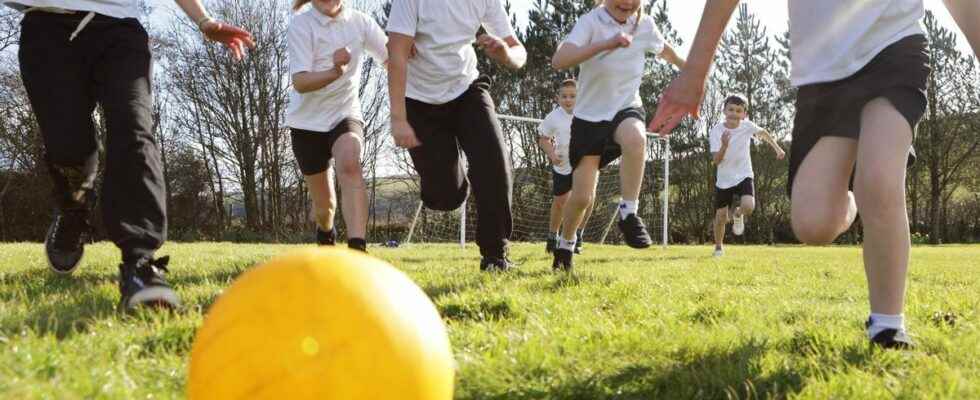Published on
Updated
Reading 4 mins.
To promote the inclusion of people with autism, doctoral student Olivia Collet is carrying out, with Play International and the VIPS² and LP3C laboratories, a project called “Sport and autism, a collective for inclusion”. The goal? Go through physical activity and sports games to support children with ASD. Interview with Oliva Collet.
Autism, called Autism Spectrum Disorder (ASD), is a neurodevelopmental disorder that affects approximately 1 in 100 births in France. Currently, there is no medical treatment for this disability. ASD affects a child’s development in communication, social interactions, and behavior.
The issue of support and integration of this population is becoming a public health issue. One of the solutions, go through the practice of sport to promote their social inclusion. This is the heart of the project “Sport and autism, a collective for inclusion” led by doctoral student Olivia Collet, within the NGO Play International, with the collaboration of the VIPS² and LP3C laboratories.
Why is the number of diagnosed cases of Autism Spectrum Disorder (ASD) constantly increasing?
Previously, it was about PDD for Pervasive Developmental Disorder. To diagnose autism, three criteria had to be met. Cumulating social interaction disorder, communication disorder and the presence of restricted, repetitive and stereotyped behaviors, interests and activities.
The modification of the diagnostic criteria makes it possible to reach a wider population. According to the Haute Autorité de Santé, there is also an improvement in the identification of health professionals in the diagnosis, even if there is still some progress to be made. An ASD can be diagnosed as early as 18 months. In France, it is laid on average between 3 and 5 years.
What place can sports practice play in supporting ASD?
Physical activity has sensory, motor, cognitive, physical, psychological and social benefits. I focused on the social aspect, because it represents the majority of the difficulties encountered by a person with ASD.
According to the scientific literature, physical activity reduces difficult behaviors, such as tantrums, anger, etc. It also reduces stereotypical behaviors, such as swaying that is very common across the autism spectrum disorder. Conversely, it promotes appropriate behaviors or ‘task behaviours’, that is to say the behaviors expected in a given situation.
Physical activity helps develop the social skills of this audience. It stimulates communication skills, increases social participation and improves interpersonal relationships. Some authors explain that physical activity creates a natural environment, which favors the social interactions of this public.
To reap the benefits, physical activity must be adapted. The environment must be adequate, for example avoiding noisy gymnasiums and selecting participants. In the case of an activity with neurotypical children, called ‘ordinary’, we can choose those sensitized to ASD for example. On the activity itself, specific interests can be used, such as the use of a yellow ball if this color is appreciated by one of the participants to bring them into the activity.
Are there differences depending on the sports practiced?
In general, cooperative physical activities and sports games are preferred.
Individual activities, appreciated by children with ASD, also contribute to developing social interactions, in particular through exchanges with the teacher. The scientific literature specifies that the sports activities in opposition also make it possible to work the social relation with the other by the concept of respect of the other, of its space.
However, collective activities can be a hindrance for people with ASD because of the obligation to interact. A sports meeting can be synonymous with pressure, in particular by their many rules. So many elements leading to stress and counterproductive reactions.
Team sport is based on competition. On a team of 10 people, one of them can be neglected, without influencing the victory. Cooperative activities involve everyone in a common goal. For example, in the context of basketball, we can adapt the rules by requiring that each player make a pass before being able to attempt to score a basket. The important thing is the notion of cooperation and exchange through all the participants.
What are the advantages for a specialized educator of going through physical activity?
As part of the project, a survey of professionals was conducted. More than 85% of respondents set up physical activities in the support of people with ASD. For the remaining 15%, half of them do not do so, because they have already been put in place by another professional in supporting the child. Regardless of the profile of the child, physical activity is necessary, whether to fight against a sedentary lifestyle, improve well-being, motor development, and for autonomy.
The special educator benefits from it on all aspects, but it is up to him to define which aspect to focus on. In the case of the social aspect, it is up to him to ask himself how he can focus specifically on this plan. He can propose activities where children must communicate with each other, perform an action. On autonomy, he can think about activities that can help him later to dress himself for example.
One of the difficulties lies in reconciling the practice of physical activity and Autism Spectrum Disorder. For the moment, there is no real training on this case. The interest of our project is to create a program to equip these professionals. Our objective is twofold, to help children with ASD, but also those who accompany them.
*Interview with Olivia Collet by our colleagues from ETX Studio
